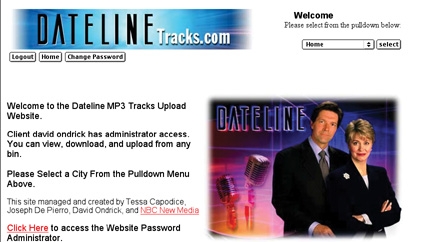Download: ECB partners with WISC-DT for datacasting

The Wisconsin Educational Communications Board (ECB), which includes the Wisconsin Public Broadcasting network, began a project to datacast rich media content to public school students and teachers in early 2001.
ECB datacast two separate pieces of content. The first was a video called “Investigating Wisconsin History,” which had been converted from Betacam tape format to MPEG-2 .m2p file format, and saved on a DVD-ROM. The second piece of content, called “Hand In Hand,” was a video with interactive enhancements including another 20 minutes of audio and video clips, maps, photographs, timelines and historical documents.
A dedicated Web site, segmented into 10 bins, one for each NBC News location, was created to facilitate the transmission of voice-overs from remote locations. Image courtesy NBC News.
“Hand In Hand” was saved as a .vob file on a CD-ROM. During the datacasting demo, ECB realized that the server had a CD drive but not a DVD drive. The DVD was transferred to two CDs for transmission.
Datacasting involves inserting data into the unused portion of a DTV signal for wireless point-to-multipoint transmission of the data to a receive card. Datacasting broadcasts data at rates significantly faster than the speed of a dial-up or cable modem.
While an 8-VSB DTV signal has a data rate of 19.39 Mbits/s, the signal's video and audio often require less than the total data rate. A standard-definition program on a DTV signal only uses 4 Mbits/s to 5 Mbits/s of the 19.4 Mbits/s bit stream. A DTV signal could simultaneously contain four SD programs at 4 Mbits/s each or 16 Mbits/s total, and still have approximately 3.39 Mbits/s left over. Non-payload-carrying bits can be removed from this space and replaced with opportunistic data.
The ECB converted video content and enhancements from Betacam tape to MPEG-2 .m2p digital files. The challenge was to get datacast content from the network headend in Madison, WI, to schools in surrounding communities since ECB lacked a DTV signal. ECB wished to datacast within months, but the expected sign-on date for its Madison PBS DTV station was a year away. ECB sought a solution and decided to partner with CBS affiliate WISC-DT Channel 3-1.
Get the TV Tech Newsletter
The professional video industry's #1 source for news, trends and product and tech information. Sign up below.
WISC-DT's primary CBS-HD feed has 15 Mbits/s peak rate for a HD signal, while their second feed, the Warner Brothers network, has 4 Mbits/s peak rate for a SD signal, and they still have roughly 0.39 Mbits/s remaining for datacasting. However, the actual bandwidth available for datacasting is higher (up to 4 Mbits/s) dependent on the actual video content and compression from the ATSC encoder.
WISC-TV had a Harris DataPlus that hadn't been connected to their ATSC signal path. The Harris DataPlus was manufactured by Skystream and then repackaged and sold by Harris as part of their ATSC transmission package. But additional software and hardware was required to datacast. To transmit data, ECB needed to acquire a server and Z-Band server software that would format and send the data to the encapsulator. For this experiment, the ECB purchased a 45-day license for the server software.
Datacast content was saved on a CD-ROM and inserted into the server PC, which transmitted the data using the PGM protocol with forward error correction. The server sends the data over an Ethernet link to the encapsulator where it is converted to MPEG-2 format. The encapsulator frees up space in the DTV data stream by PID filtering — dropping certain packet identifiers from the transport stream. Null packets generated by the ATSC encoder are replaced with data packets. After the data is piggybacked onto the DTV signal, it exits the encapsulator through the SMPTE 310M out port and is sent to the modulator. (See Figure 1.)
To receive the datacast, the receive site needs an inexpensive UHF antenna, a receive PC, a PC receive card and software. The ASIC FlexCop digital receive chip provides the functionality of the receive card. To meet minimum requirements, the receive computer should be a Pentium II 300 MHz or Celeron 366 MHz, running Windows 98SE, NT 4.0, 2000 or ME operating system, with at least 64 Mbits of RAM and 10 MBytes of hard disk space, and an open PCI or USB slot for the receive card. The receive card extracts data from the DTV signal. The computer saves the file in whatever format it was transmitted in. Metadata in the datacast will inform the PC receive card how much hard drive space the corresponding file requires. The receive PC will save the datacast file only if it has enough storage space available for the entire file. An optional telephone back channel allows the receive PC to request content to be sent.
When datacasting with the Z-Band server, the user sets an expiry date for each content file, after which the file is automatically deleted from the receive computer. This is a convenient way to manage timely content that will become outdated or that has a limited time period for playback rights.
Schools could save these datacast files on their network server and then send files on their network (ideally running at 100 Mbits/s or faster) to a computer for display on an LCD projector or an individual's computer.
The ECB has found applications for DTV datacasting technology, including sending teacher guides to accompany educational programs. The board could also send the bulky printed catalog of educational programs in this manner instead of mailing it to each school. A commercial broadcaster might transmit either data that corresponds to their DTV programming, or consumer or business data such as software, Web sites, music, movies, weather, sports statistics or even ISP traffic.
Vicki Way Kipp, CBTE, CBNT, is a media technician for the Educational Communications Board in Wisconsin.
